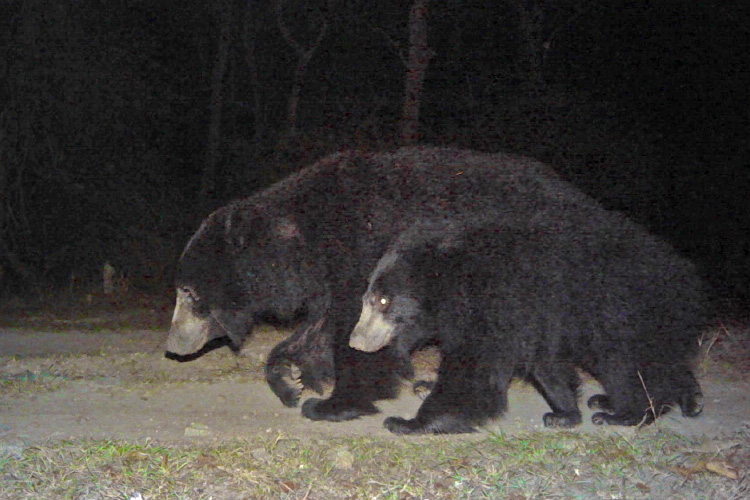Endemic to the Indian subcontinent, the Sloth Bear (Melursus ursinus) inhabits tropical and sub-tropical habitats across India, Nepal, Bhutan and Sri Lanka. Being the most common among the four species of bears in India, it is widely distributed from the foothills of the Himalayas to the southern tip of the Indian peninsula. With sloth bear populations in the Himalayan foothills and northeast India becoming isolated, the Western Ghats and central Indian landscapes now possibly harbor the largest populations.
Despite their relatively extensive range, information on much of sloth bear ecology remains largely unknown. Based on crude population estimates and site-specific radio telemetric studies, they are listed as ‘vulnerable’ by IUCN and placed under Schedule I of India’s Wildlife Protection Act (1972). Most of the areas currently occupied by bears are either highly fragmented or at the risk of future fragmentation from changing land-use and infrastructure development projects. Degradation and loss of forests caused by fire, overgrazing, and over-extraction of forest resources has resulted in a presumed 30-49% decline in bear populations over the last 30 years. Their recent extinction from Bangladesh further emphasizes their vulnerability. Additionally, poaching, trade of body parts and capture of live cubs for entertainment (as ‘dancing bears’ in India) continue to threaten bear populations.
In a recent study, scientists from Wildlife Conservation Society India Program examined sloth bear range limits within India (covering 2,969,340 km2 of potential bear habitat) and proportion of area occupied by the species within Western Ghats region of Karnataka (38,540 km2, of which ~ 21,000 km2 is covered by forests). The study examined ecological and human-induced factors that determine patterns of sloth bear distribution at the two levels.
For countywide assessments, over 100 Indian wildlife experts were interviewed, based on their field experience and knowledge of particular regions. In Western Ghats, indirect sign surveys were conducted for scats and tracks, walking over 4000 km across the landscape. The study relied on advanced habitat occupancy-modelling methods to estimate and map patterns of sloth bear distribution.
The study found that sloth bears occupied 67% of potential habitat in India, with the highest probabilities of sloth bear occurrence in the landscapes linking the central Indian highlands with tropical forests of the southern peninsula. Occurrence of sloth bears was not limited to protected areas, and they were found widely distributed even in unprotected, multi-use forests. Although bear distribution overlapped with areas of high human densities, cultural tolerance by people favoured their presence. Within Western Ghats, sloth bears occupied nearly 61% (nearly 15,000 km2) of the landscape’s forests, preferring drier forests and rough terrains. Of this, less than 9000 km2 area is under designated wildlife reserves. These results also showed that at finer-scales, bears generally avoided human presence.
Based on these findings, the study concludes that it is important to recognize the potential of multi-use forests, open scrub and barren lands to support large populations of sloth bears, and the need to integrate these habitats with the country’s existing protected area network. Given the sloth bears’ widespread nature, functional role, conservation status and relatively benign interaction with humans, the study recognizes the potential of sloth bears as suitable umbrella species for securing unprotected habitats in India. This could help prioritize areas for conserving wildlife across larger landscapes, and at the same time, complement current conservation strategies for other large mammals like leopards, wolves and hyenas, which are found in similar habitats.
Citation: Puri, M., Srivathsa, A., Karanth, K. K., Kumar, N., & Karanth, K. U. (2015). Multiscale distribution models for conserving widespread species: the case of sloth bear Melursus ursinus in India. Diversity and Distributions. DOI: 10.1111/ddi.12335


 CI is a non-profit, non-commercial portal that aims to facilitate wildlife and nature conservation by providing reliable information and the tools needed to campaign effectively.
CI is a non-profit, non-commercial portal that aims to facilitate wildlife and nature conservation by providing reliable information and the tools needed to campaign effectively.